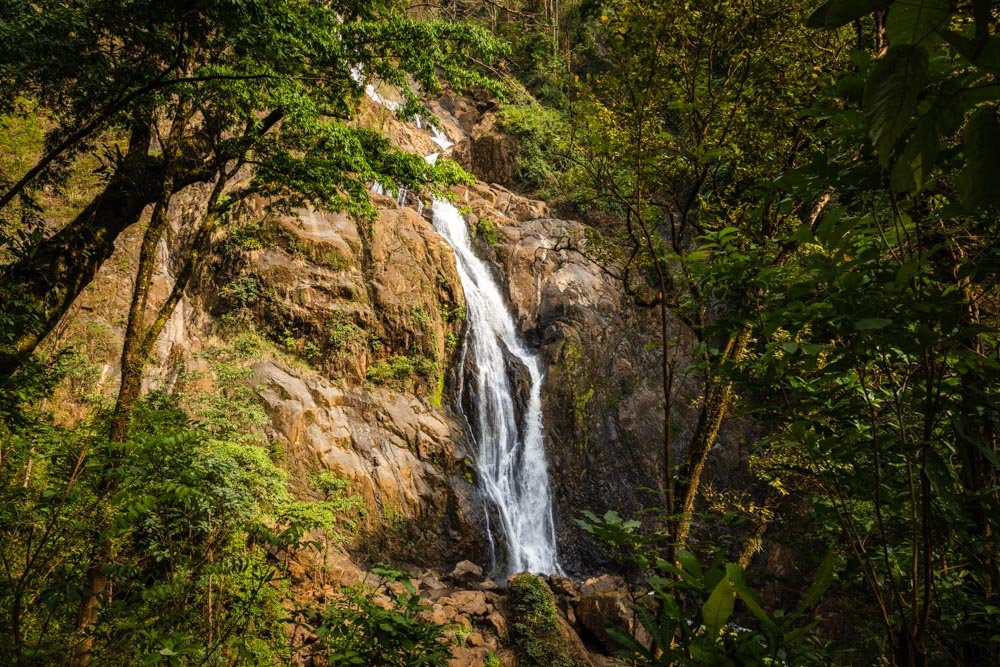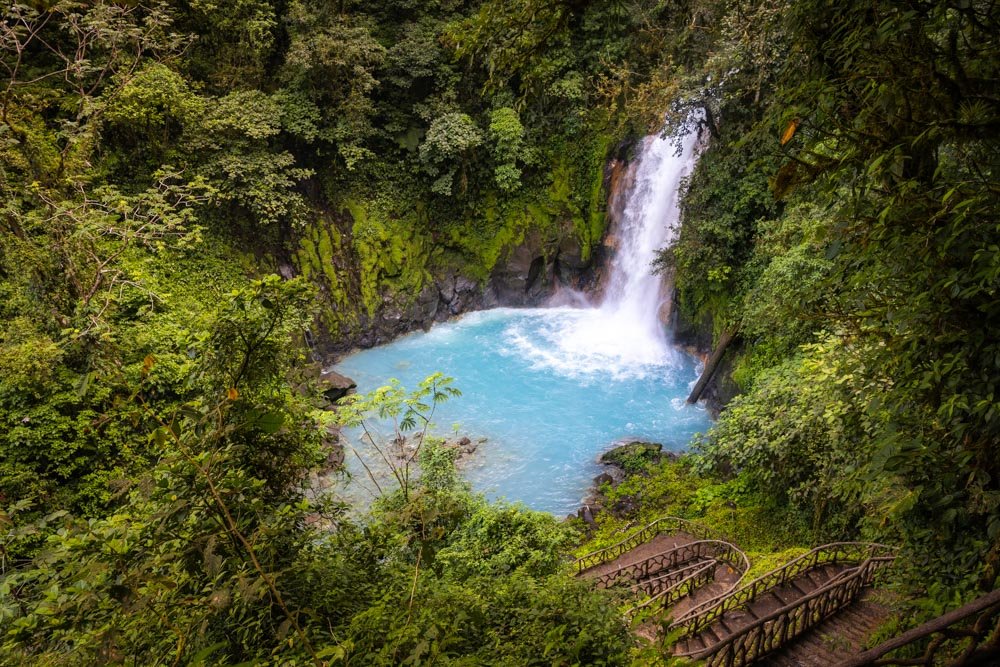Although Poas Volcano is very much a sleeping giant, it’s currently ‘muy tranquilo’ as the Costa Ricans would say, it’s still a fun place to visit. There’s no longer the requirement for guided tours, hard hats, or 20 minute maximum stays that were enforced as recently as 2022. Today you can walk right up to the lookout yourself in the same way you would any other scenic viewpoint. There’s not much in the way of volcanic activity to see, although there a still a few minor steaming vents.
So with all this in mind - given it’s a national park with a USD $15 (plus tax) entry fee for foreigners - is it actually worth it?
Here’s what to expect on a visit to Poas Volcano and whether we thought it was worth it.
What to expect when visiting Poas Volcano
The walk to get there
Distance: 700m each way
We arrived at Poas Volcano expecting that we needed to take a guided tour, don a hard hat and only stay for 20 minutes, as had previously been the case when the volcano was more active (I guess all those “2023 guides” online were not actually written in 2023!).
We stood around waiting to hear what the process would be before we realised that we could just walk right up to the viewpoint ourselves.
It’s an easy 700m walk each way to reach the main viewing platform. The first 650m are all along a road (although no cars use it, so it’s pleasant enough) and the final 50m are on a track and take you into the ‘danger zone’ - although as discussed, it’s far less dangerous at the moment!
Although the road does head gently uphill all the way, it’s easy enough. The only thing you may notice if you’ve come from sea level is a slight shortness of breath from the change in altitude, as the volcano sits just below 2,700m above sea level.
It’s not too bad, but I did notice a slight breathlessness going uphill, which I am of course putting down to altitude and not a general lack of fitness : )
The Poas Volcano viewing platforms
Once you finish the short walk you’ll arrive at the main viewing area. There are seven platforms in total, both above and below the main lookout.
There are just a few steps inbetween each one and they all offer a similar view, just at slightly different elevations. The view itself is fantastic - although you’ll need a clear day, more on that below.
The crater is huge and the crater lake is a striking teal colour. Although there is no longer (for now anyway) steam coming off the main lake, if you look closely you will see a couple of small vents around the edges of the crater.
It’s an impressive view regardless of the lack of obvious volcanic activity and it’s definitely one of the largest craters we’ve ever seen.
You also get some lovely views over the forested hills of Bajos del Toro and we saw a wave of cloud making its way up the valley, which was mesmerising to watch.
The conditions required to see Poas Volcano
Due to its location in a cloud forest, Poas Volcano often stubbornly hides behind a thick layer of cloud. This is slightly less problematic today than it used to be (when your visit was limited to 20 minutes) so you can wait and hope for the clouds to clear.
However, if you want to give yourself the best chance at seeing the volcano, then we’d recommend checking the weather forecast carefully.
Whilst all weather forecasts can be inaccurate (especially in Costa Rica) we actually found the one we use to be quite good for the Poas area.
You want to head to this website and check the details tab (don’t just look at the weather hour by hour). Scroll across to the cloud cover percentage columns on the right side and check what is written in the fog, low and middle cloud categories.
You want the percentages to be low, as close to 0 as possible, in the low and middle cloud categories. High cloud will sit above the volcano, so it is less important.
You may get away with some middle cloud, but if you see an hour where the cloud is low in both the low and middle categories, that’s the time to go.
There’s no real rhyme or reason to the weather here, so a visit in dry season is not necessarily going to better than the rainy season.
In fact, we tried to visit many times in the dry season and the volcano was under constant thick cloud every time. The time we got great conditions was during a visit in the rainy season.
The second crater lake at Poas Volcano - Lake Botos
There is a second crater lake at Poas Volcano, known as Lake Botos. You can choose to walk up to the lake from the main Poas Volcano viewpoint and return the same way (the shortest option) or complete a loop through the cloud forest back to the car park.
The lake is located 700m (each way) from the main Poas viewpoint. Completing the circuit track is an additional 1.15km (2.55km from the main viewpoint back to the car park).
Reaching the lake from the main viewpoint is on an uphill track for the first 600m. The track is paved and in good condition, but the altitude does make it that touch harder than it would be at sea level.
The walk takes you through cloud forest, but it’s not dense like at Monteverde and Santa Elena, so it’s not as beautiful. It’s not that it’s not pleasant by any means, but I think the term ‘cloud forest’ makes it seem more evocative than it actually is.
Lake Botos however is gorgeous. It’s a deep almost iridescent blue and looks particularly spectacular in the sunshine.
It’s well worth heading up to the viewpoint, even if you don’t want to walk the full circuit. Sadly you can’t get very close to the lake, but you do have a very good elevated view.
If you want to continue the loop track then you’ll have a few more ups and downs, but it’s not too challenging. The track is in great condition and there’s a lovely stretch of boardwalk just after the lake.
You’re walking inbetween cloud forest, but rarely under the canopy, so it doesn’t have quite the same effect as other forest walks in Costa Rica.
However, it’s pretty enough and we saw many hummingbirds, which is always a delight. It’s not a must do, but if you fancy a bit more of a stroll, it’s worth a look.
It will drop you back at the car park, so you don’t need to return to the visitor centre.
So is it worth visiting Poas Volcano?
I’m not going to lie, when I saw that Poas Volcano was no longer looking steamy and active, I was a bit disappointed. The view is terrific - don’t get me wrong - but it doesn’t have quite the same effect as when it’s billowing with steam.
I was still glad to have seen it, because the view is incredible, but I’d say that if you’ve seen volcanoes with coloured crater lakes in places like New Zealand, you will likely not feel that it’s a must do. And I am assuming that you are probably holidaying in Costa Rica and don’t have as much time as we were lucky enough to have there.
Similarly if you are keeping a close eye on the budget, then you may not feel it’s worth the money right now.
Overall, I was happy we went, but I do wish we’d seen it in a time of greater activity.
What to pair a visit to Poas Volcano with
If you’re day tripping from San Jose, or on route to La Fortuna, we’d recommend pairing Poas Volcano with a visit to nearby Hacienda Alsacia Starbucks Coffee Farm, just a 30 minute drive away (it’s on the way to San Jose, so it isn’t a detour if that’s your route).
Now before any coffee snobs switch off (I hear you, I’m one of you) just know that you’re not coming for the coffee. This has to be one of the most spectacular cafes we’ve ever been to, and surely the most beautiful Starbucks in the world.
The way the open air cafe has been done; from the seating to the landscaping, is utterly gorgeous. The sweeping view - which stretches the full length of the terrace - took my breath away. Rolling hills, trees galore and even it’s own waterfall!
It really has to be seen to be believed. There are lots of rocking chairs along the edge of the terrace which offer an uninterrupted vista.
The coffee tastes like any other Starbucks around the world, but the tea is nice enough and there’s a decent food selection. It’s pricy even by Costa Rican standards, but it’s worth it for the experience.
You can also take a coffee tour here, although we opted simply to enjoy the cafe.
There’s plenty of free parking onsite and good wifi if needed.
Poas Volcano opening hours and entry fees
Poas Volcano is located in the Poas Volcano National Park and as such incurs an entry fee. At time of writing it’s USD $15 plus tax for adult foreigners (over 13 years old). Children are USD $5 and residents pay significantly less.
Tickets must be booked in advance on the government website.
You must create an account, like you do for Manuel Antonio and Tortuguero National Parks and then select Poas Volcano National Park. You’ll see a series of time slots and must select one, as visitor numbers are still limited. You’ll then present your confirmation at the ticket booth as you drive into the park.
At time of writing the park is open from 8am to 4pm, with 2pm being the final entry ticket you can book.
Note that there is a parking fee of 2,000 colones (USD $3.50) to park here, which is collected as you drive through.
Getting to Poas Volcano
Poas Volcano is located 50km from San Jose (about 1 hour 15) and 110km from La Fortuna (about 2.5 hours). The road is steep at points, but is fully paved and suitable for any vehicles.
Arriving by public transport is possible, but needs to be planned carefully with your ticket time, you can see the details here.
This post may contain affiliate links, meaning at no additional cost to you, we will earn a small commission if you click through and decide to make a purchase. This helps towards the costs of running our website. Thanks for your support.

















































